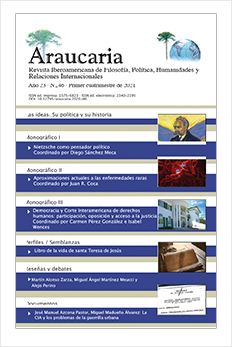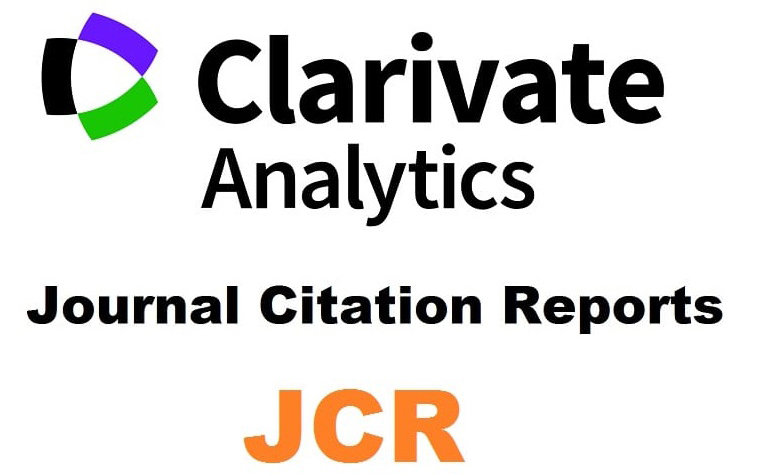La importancia de los registros de pacientes con Enfermedades Raras de la visión para la investigación en ciencias sociales
DOI:
https://doi.org/10.12795/araucaria.2021.i46.19Palabras clave:
Enfermedades Raras de la visión, distrofias de retina, registro de pacientes, investigación socialResumen
El propósito de este artículo ha sido evidenciar lo que las ciencias sociales pueden aportar para avanzar en el conocimiento y comprensión de los problemas personales y sociales derivados de padecer Enfermedades Raras de la visión. Se concluye que la incorporación de datos, en los Registros Nacionales de Pacientes, es una oportunidad para favorecer la investigación de los problemas existentes en nuestro contexto social y cultural, en la búsqueda de soluciones que redunde en la mejora de los tratamientos, de la atención sanitaria, psico-social, de la educación, en el empleo, etc. y en la evaluación de los resultados. En definitiva, en las condiciones y calidad de vida de los pacientes y sus familiares.
Descargas
Citas
with achromatopsia.
Álamo-Martín, M. a T. del y Álamo-Martín, M.A. del. (2019). Visibilizando a las personas con patología ocular grave para el Trabajo Social Sanitario y la defensa de sus derechos. Trabajo Social y Salud, 92, 5-20.
American Sociological Association. (2018). Code of Ethics Code of Ethics. Code of Ethics, 104(911), 1–21. Retrieved from https://nhaa.org.au/about/code-of-ethics-constitution?highlight=WyJjb2RlIiwib2YiLCJldGhpY3MiLCJjb2RlIG9mIiwiY29kZSBvZiBldGhpY3MiLCJvZiBldGhpY3MiXQ==%0Ahttp://www.aamft.org/imis15/Content/Legal_Ethics/Code_of_Ethics.aspx
Anil, K. y Garip, G. (2018). Coping strategies, vision-related quality of life, and emotional health in managing retinitis pigmentosa: A survey study. BMC Ophthalmology, 18(1), 1-12. http://doi.org/10.1186/s12886-018-0689-2
Brinks, M.V., Redd, T., Lambert, W.E., Zaback, T., Randall, J., Field, T. y Wilson, D. (2019). Using registry data to characterize the incidence and causes of blindness in Oregon. PLoS ONE, 14(8), 1-9. http://doi.org/10.1371/journal.pone.0220983
Chacón-López, H. y López-Justicia, M.D. (2020). Self-Concept difficulties according to sex and studies of young people with retinitis pigmentosa. Revista Española de Orientacion y Psicopedagogia, 31(1), 98-112. http://doi.org/10.5944/reop.vol.31.num.1.2020.27292
Chaumet-Riffaud, A.E., Chaumet-Riffaud, P., Cariou, A., Devisme, C., Audo, I., Sahel, J.A., y Mohand-Said, S. (2017). Impact of Retinitis Pigmentosa on Quality of Life, Mental Health, and Employment Among Young Adults. American Journal of Ophthalmology, 177, 169-174. http://doi.org/10.1016/j.ajo.2017.02.016
Dean, G., Orford, A., Staines, R., McGee, A., y Smith, K.J. (2017). Psychosocial well-being and healthrelated quality of life in a UK population with Usher syndrome. BMJ Open, 7(1), 1–9. http://doi.org/10.1136/bmjopen-2016-013261
De Roach, J., McLaren, T., Paterson, R., O’Brien, E., Hoffman, L., Mackey, D.A., … Lamey, I. (2012). Establishment and evolution of the Australian Inherited Retinal Disease Register and DNA Bank. Clinical and Experimental Ophthalmology, 41(5), 476-483.
Fillat, C., Río, M. del, Martínez-Santarmaría, L. y Bueren, J.A. (2018). Terapias avanzadas en Enfermedades Raras. Arbor, 194(789), a467.
Garip, G. y Kamal, A. (2019). Systematic review and meta-synthesis of coping with retinitis pigmentosa: Implications for improving quality of life. BMC Ophthalmology, 19(1), 1-16. http://doi.org/10.1186/s12886-019-1169-z
Heesterbeek, T. J., van der Aa, H. P. A., van Rens, G.H.M.B., Twisk, J.W.R. y van Nispen, R.M.A. (2017). The incidence and predictors of depressive and anxiety symptoms in older adults with vision impairment: a longitudinal prospective cohort study. Ophthalmic and Physiological Optics. http://doi.org/10.1111/opo.12388
Kempen, G.I.J.M. y Zijlstra, G.A.R. (2014). Clinically relevant symptoms of anxiety and depression in low-vision community-living older adults. American Journal of Geriatric Psychiatry, 22(3), 309-313. http://doi.org/10.1016/j.jagp.2012.08.007
Lawrenson, J.G., Graham-Rowe, E., Lorencatto, F., Burr, J., Bunce, C., Francis, J. J., … Grimshaw, J.M. (2018). Interventions to increase attendance for diabetic retinopathy screening. Cochrane Database of Systematic Reviews. http://doi.org/10.1002/14651858.CD012054.pub2
Lønborg-Møller, H., Subhi, Y. y Kessel, L. (2020). Living with Usher Syndrome: Patient and Physician Perspectives. Ophthalmology and Therapy, 9(3). http://doi.org/10.1007/s40123-020-00258-6
López-Justicia, M.D., y Chacón-López, H. (2015). Cambios emocionales asociados a la edad y género en personas con retinosis pigmentaria. Revista Argentina de Clinica Psicologica, XXIV(August), 57-66.
Mansfield, B.C., Yerxa, B.R., y Branham, K.H. (2020). Implementation of a registry and open access genetic testing program for inherited retinal diseases within a non-profit foundation. American Journal of Medical Genetics, Part C: Seminars in Medical Genetics, (June), 838-845. http://doi.org/10.1002/ajmg.c.31825
Matsunaga, T. (2020). Clinical genetics, practice, and research of deafblindness: From uncollected experiences to the national registry in Japan. Auris Nasus Larynx, (xxxx). http://doi.org/10.1016/j.anl.2020.08.017
Metzelthin, S.F., Zijlstra, G.A., van Rossum, E., de Man-van Ginkel, J.M., Resnick, B., Lewin, G., … Kempen, G.I. (2017). “Doing with …” rather than “doing for …” older adults: rationale and content of the “Stay Active at Home” programme. Clinical Rehabilitation, 26921551769873. http://doi.org/10.1177/0269215517698733
Millán Salvador, J.M. (2018). Enfermedades Raras de la visión. Arbor, 194(789), 462. http://doi.org/10.3989/arbor.2018.789n3004
Moschos, M.M., Nitoda, E. y Lavaris, A. (2015). Estimation of depression prevalence in patients with stargardt disease using PHQ-9 and zung scores. European Journal of Ophthalmology, 26(3), 268-272. http://doi.org/10.5301/ejo.5000700
Nollett, C., Ryan, B., Bray, N., Bunce, C., Casten, R., Edwards, R.T., … Margrain, T.H. (2019). Depressive symptoms in people with vision impairment: a cross-sectional study to identify who is most at risk. BMJ Open, 9(1), e026163. http://doi.org/10.1136/bmjopen-2018-026163
OMS. (2005). Determinantes sociales de la salud. Retrieved from http://www.who.int/social_determinants/es/.
Oviedo, M. del P., Hernández, M.L. y Ruíz, M. (2015). Baja visión en Colombia: una situación invisible para el país. Revista Facultad Nacional de Salud Pública., 33(1), 22-30. Retrieved from http://aprendeenlinea.udea.edu.co/revistas/index.php/fnsp/article/view/16499/20779829
Owsley, C. (2011). Aging and vision. Vision Research. http://doi.org/10.1016/j.visres.2010.10.020
Pybis, J., Thurston, M., Dennison, C.M., Broom, M. y Miller, A. (2016). The nature of emotional support and counselling provision for people with sight loss in the United Kingdom. British Journal of Visual Impairment, 34(2), 169-178. http://doi.org/10.1177/0264619616633884
Roborel de Climens, A., Tugaut, B., Piscopo, A., Arnould, B., Buggage, R. y Brun-Strang, C. (2020). Living with type I Usher syndrome: insights from patients and their parents. Ophthalmic Genetics, 41(3), 240-251. http://doi.org/10.1080/13816810.2020.1737947
Sainohira, M., Yamashita, T., Terasaki, H., Sonoda, S., Miyata, K., Murakami, Y., … Sakamoto, T. (2018). Quantitative analyses of factors related to anxiety and depression in patients with retinitis pigmentosa. PLoS ONE, 13(4), 1-9. http://doi.org/10.1371/journal.pone.0195983
Sauces, M.O.S. y Callado, R.R. (2016). Las Enfermedades Raras en España. Un enfoque social. Prisma Social, (17), 373-395.
Shaberman, B. y Durham, T. (2019). The foundation fighting blindness plays an essential and expansive role in driving genetic research for inherited retinal diseases. Genes, 10(7). http://doi.org/10.3390/genes10070511
Smallfield, S., Berger, S., Hillman, B., Saltzgaber, P., Giger, J. y Kaldenberg, J. (2017). Living with low vision: Strategies supporting daily activity. Occupational Therapy in Health Care, 31(4), 312-328. http://doi.org/10.1080/07380577.2017.1384969
Stevenson, M.R., Hart, P.M., Montgomery, A.M., McCulloch, D.W. y Chakravarthy, U. (2004). Reduced vision in older adults with age related macular degeneration interferes with ability to care for self and impairs role as carer. British Journal of Ophthalmology, 88.
Toboso-Martín, M., y Rogero-García, J. (2012). “Diseño para todos” en la investigación social sobre personas con discapacidad. Revista Española de Investigaciones Sociológicas, 163-172. http://doi.org/10.5477/cis/reis.140.163
Ulldemolins, A.R., Benach, J., Guisasola, L. y Artazcoz, L. (2019). Why are there gender inequalities in visual impairment? European Journal of Public Health, 29(4), 661-666. http://doi.org/10.1093/eurpub/cky245
Zapata, M. (2018). Personal Disability Identity in Retinitis Pigmentosa. Rehabilitation Psychology, 63(4). http://doi.org/10.1037/rep0000238
Zurriaga, Ó., Martínez, J., Corrochano, V. y Cavero-Carbonell, C. (2018). Registros y biobancos de Enfermedades Raras. Una oportunidad para avanzar. Arbor, 194(789), 469. http://doi.org/10.3989/arbor.2018.789n3011
Descargas
Publicado
Cómo citar
Número
Sección
Licencia
Las ediciones impresa y electrónica de esta Revista son editadas por el Secretariado de Publicaciones de la Universidad de Sevilla, siendo necesario citar la procedencia en cualquier reproducción parcial o total.Salvo indicación contraria, todos los contenidos de la edición electrónica se distribuyen bajo una licencia de uso y distribución “Creative Commons Atribución-NoComercial-SinDerivar 4.0 Internacional”








